


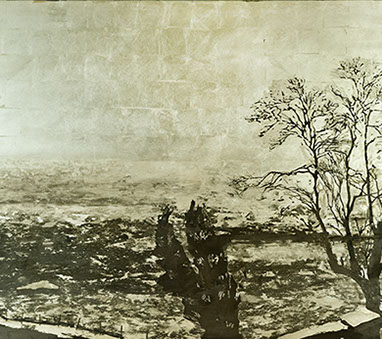






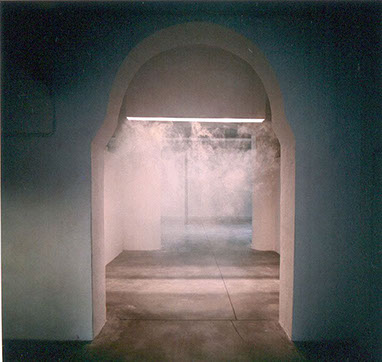
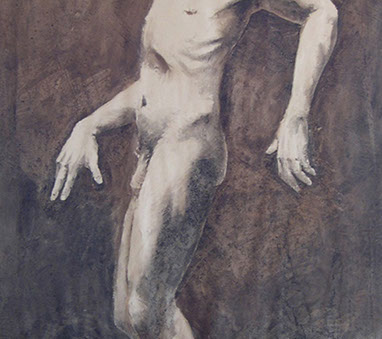



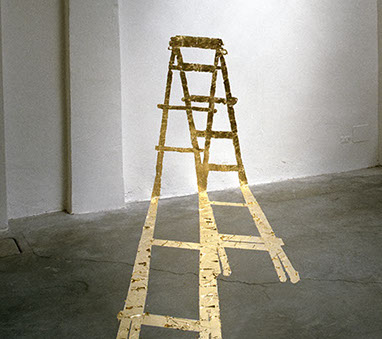

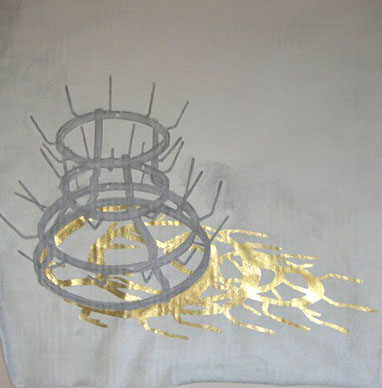

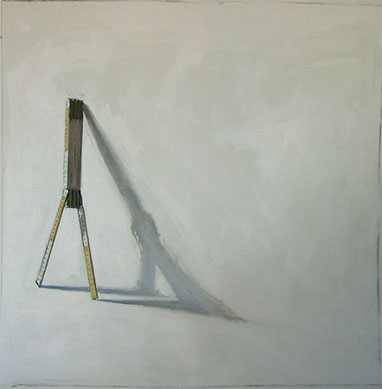

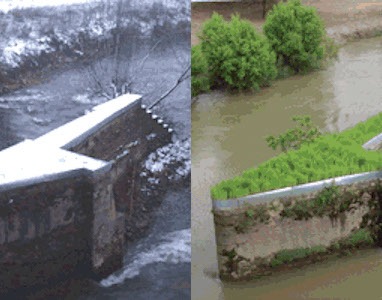




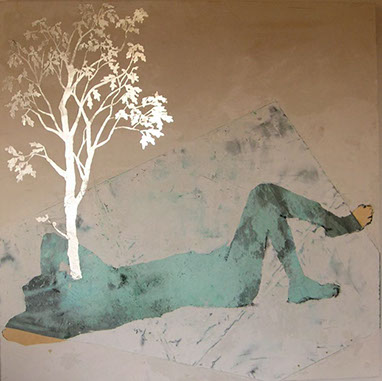



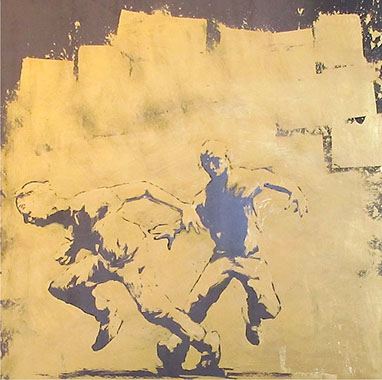









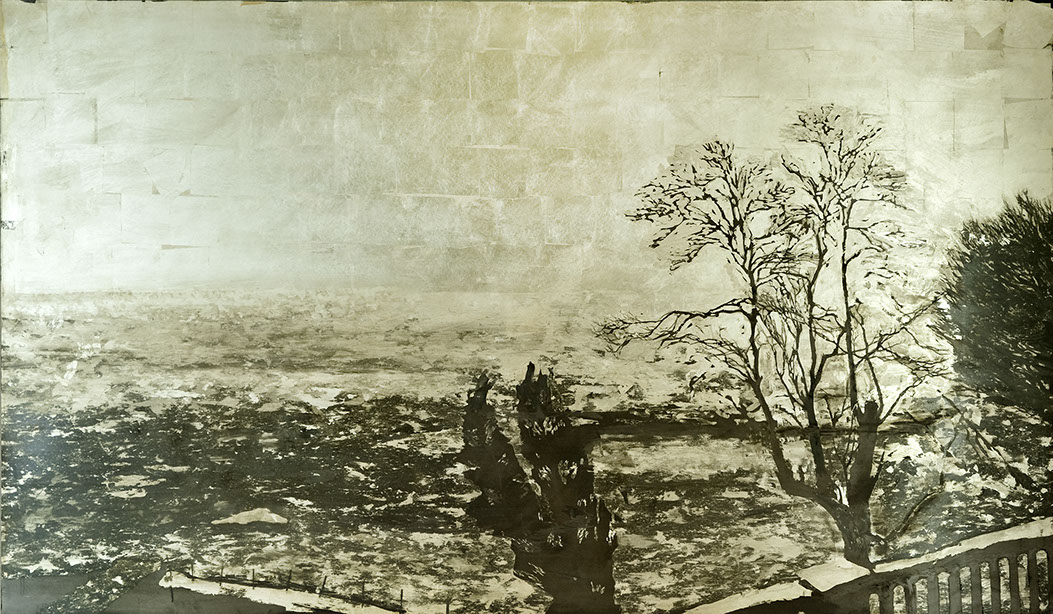


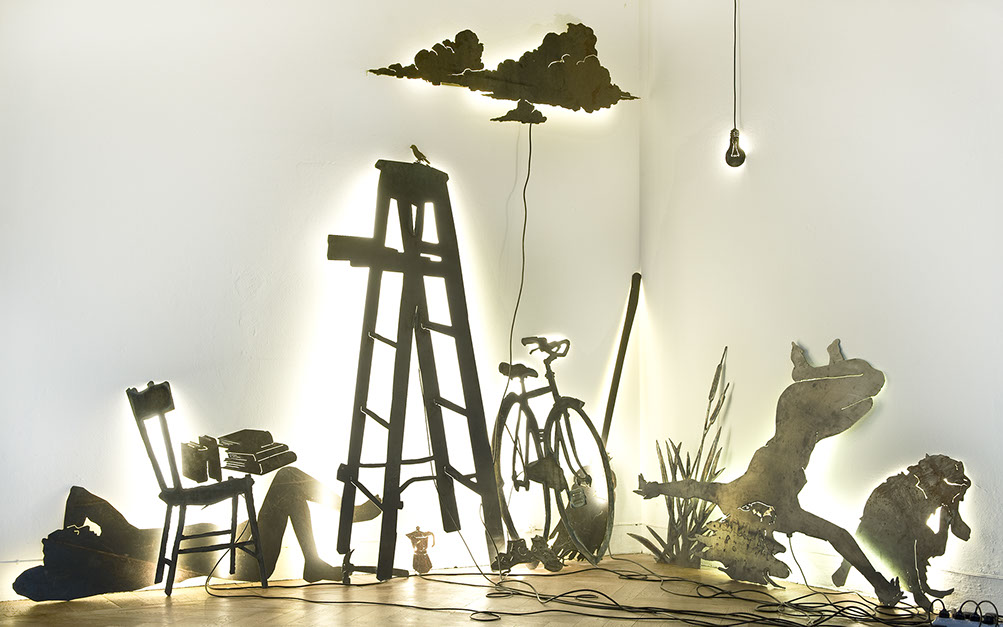






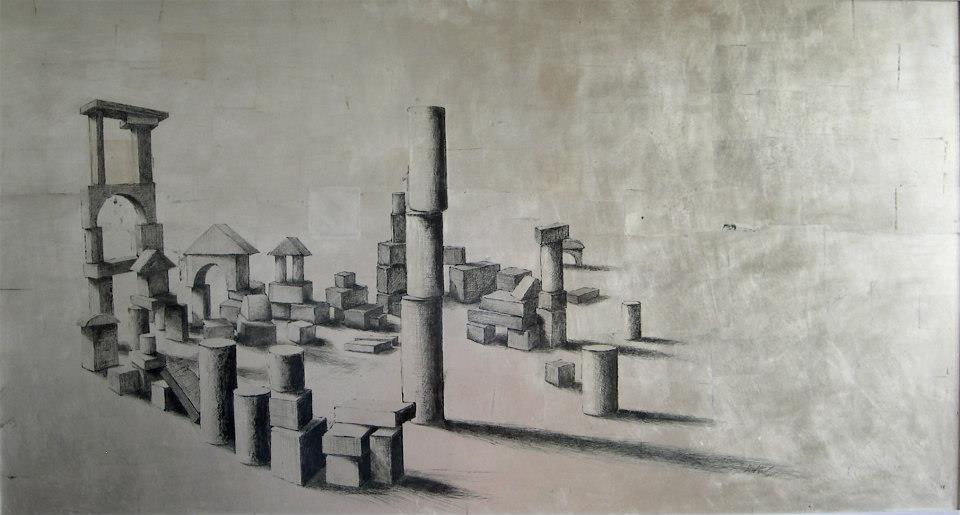









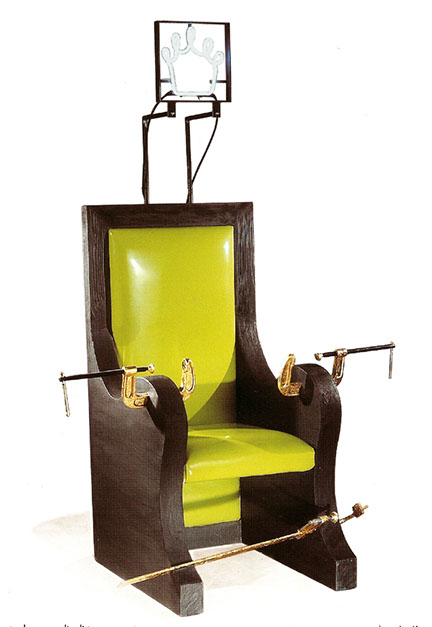
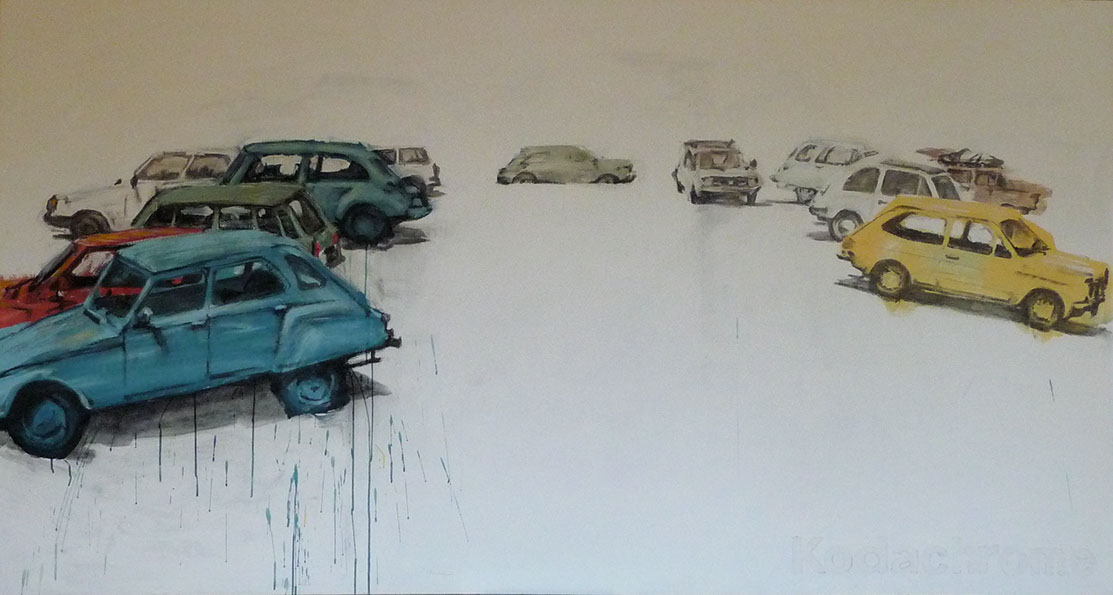

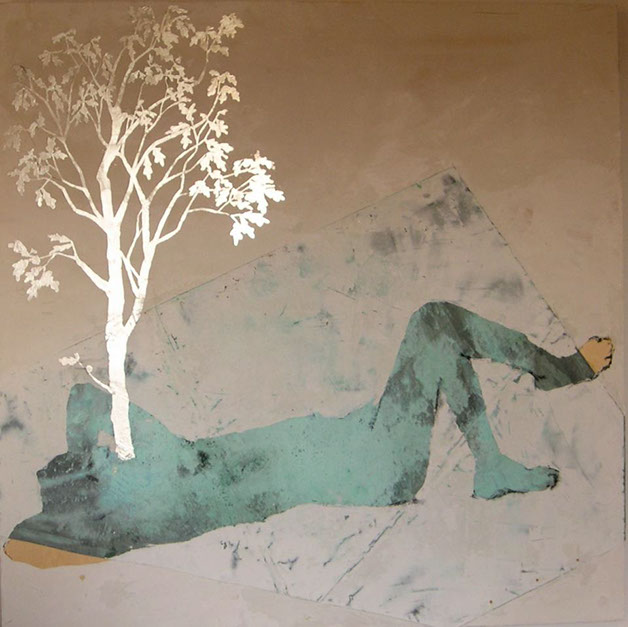











SLAPSTICK (White Gold leaf on Steel)
Broussard's realistic and prosaic images don't exclude an interpretation that touches on the magic realism of Borges or the Neue Sachlichkeit works of Grosz, Dix and Beckman. Fixed, disjointed images, a quotidian moment flash-written with white gold on steel...
E/O (Gold Leaf on Steel)
The title: e/o, is Italian for 'and/or' which are vowels from the word 'hero'. The work uses the image of Benvenuto Cellini’s 1545 bronze sculpture "Perseus with the head of Medusa" to comment on our archetypal concept of hero. Does the gesture look familiar?
WINTER FORMULAE (White Gold Leaf on Steel) 67" x 40"
A photograph immortalized the icy Hudson River on one winter day among many. I don’t know why this image affected me so strongly; perhaps for its resonance with Tomas Tranströmer’s poem, that speaks of our souls transformed by winter, as water is transformed by the cold, or the steel linearity of David Smith’s landscapes.
CALAVERA (White Gold Leaf on Steel) 50" x 60"
Inspired by both Basquiat’s Riding with Death, depicting a Griot figure riding a skeleton, and the penultimate scene of La Dolce Vita: complex, ambiguous, power games. References to popular turn of the century Mexican prints are evident, even in the title. The calaveras present death as a character on par with the living, reflecting elements from the torments of Bosch’s Christ and the medieval passion play.
COURTESY (White Gold Leaf on Steel) 50" x 50")
Homage to Paul Klee’s 1903 etching Zwei Männer, einander in höherer Stellung vermutend, begegnen sich (Two Men Meet, Each Supposing the Other to Be of Higher Rank) the choice of white gold leaf on steel echoes some of the visual aspects of an etching while the image itself comments on both the eternal and often ridiculous rituals of social hierarchy by juxtaposing antiquated, courtly gestures and contemporary business men in the context of an ambiguous, implied picture plane.
TINKER (Steel, LED Lights)
Imagine that rather than standing still and seeing the light pass through the tree branches, you perceive that the living tree is the source of that light. We’re so accustomed to the quotidian that authentic living requires an effort: to react.
PROPHET (Cast-iron hook and pulley, 22k gold leaf, acrylic paint) 24" x 8" x 35.5"
It's a warning: suspended loads. It’s a sword of Damocles. It’s a question mark that hovers over our heads, knowing that fate is hanging over you even when you don’t want to see it, as heavy as a boulder or a construction crane. It’s there waiting for you or pretending to meet you by chance. The doubt? That this work is all a game.
DEW (White Gold Leaf on Lilly Stems, Light) 6" x 12" x 158"
The gilded lily has an exceptional place in everyone’s memory and in the nature of many cultures. It’s a banner for some while it can be a toy sword for others. Certainly each one is unique. Lightness projects upward from its vertical opposite: the wall: expansive, solid, massive – while the horizontal hurls fragility, in all its grandeur and majesty, between constant symmetry and infinite variations.
ABACUS (Steel, Glass, Marble, Light, Found Objects)
Science works by way of categories. It creates a series of parameters with which to measure anything, up to and including madness itself; and through calculation inherent to its own categories, draws appropriate conclusions, judgments and therapies. But categories applied from without don't always reflect the experience of madness nor indicate real solutions. The abacus becomes a map of the body composed of various vessels for various aspects of the human condition…but the container doesn't always coincide with its contents.
ANTECAMERA (Aluminum, Halogen Lights, Smoke Machine)
Within the art gallery one's expectations are altered. As with any ritual space, the coordinates within the gallery change, leaving behind the normal reading of things, gestures and space. Light is used in an attempt indicate a passage: a threshold, past which one must pay close attention: I don't think we're in Kansas anymore…
BÊTE (Charcoal on Primed Paper)
An agonizing revelation… perhaps a relief to discover one's inner demons.
BIG FAN (Oil on Unstretched Canvass)
An explicit, unstretched homage to Claes Oldenburg
CITTÀ DEL SOLE (Gold Leaf on Mild Steel)
Our ideas of space are obviously governed by our social paradigm. What a city is and what it aims to be is the subject of intense study and rhetoric and struggle. Perhaps the way cities actually evolve is uncomfortably faithful to what we are as a society rather than what we aspire to. The paradigm is so ingrained that it can be seen even in a child's model, made with wooden blocks. Interestingly, a child takes the paradigm in good faith, assuming that the city actually corresponds to the model.
DE RERUM NATURA (Enamel on Steel)
The structure and order of this gasworks from the early 20th century embodies the whole rational Weltanschauung of its day. This model of the heavens which contains gas puts me in mind of the invisible ether or crystalline, which conveniently filled in the gaps in earlier cosmologies. Like those earlier philosophical substances, gas expands to fill all available space.
DECLINAZIONE (Gold Leaf)
Shadows are normally thought as the simple absence of light. Here the impression is turned around. Using gold leaf to trace the shadow of an ordinary object, the mark becomes positive. The gold's brilliance moves towards the viewer. Seen from the same angle as the light which created the original shadow, the drawing seems to reconstruct itself as an object, loosing it's adherence to floor and wall. Shadow takes on its Shakespearean meaning of image, or double: devoid of substance but reflecting something essential of its subject.
DEVELOPMENT OF A CAN OF DURHAM'S WATER PUTTY IN SPACE (Welded Steel & Can)
There's something about the label of a can of Durham's Water Putty which sums up the priorities of Boccioni and the Futurist movement in general: the muscular vigor of Rocky, the volumetric geometry of the can, the emphatic typography… Homage to a master.
DIAGRAM (Charcoal, Acrylic, Gold on Unstretched Ticking)
Marcel Duchamp's claim of aesthetic neutrality is, if not savvy hypocrisy, perhaps dated by his own doing. The bottle rack, his first readymade, is an object we learned to appreciate for it's formal qualities as well as it's history. That Duchamp comes immediately to mind when seeing such a bottle rack in a non-art setting indicates of the strength of that history. The object's shadow is much longer and more luminous than the object itself; hence the title. The structure of the bottle rack, tiers and symmetry, seems like a diagram as well.
EMPIRE (Theatre Seating, Tape Measures, Chalkboard, Slogans)
Units of measure have been used throughout history as instruments of administration, control and dominion by empires the world over. In this game participants compete to extend their rule/tape measure, marked in "British Imperial Units" (inches), as far as possible before one collapses under its own weight: the destiny of all empires. The players then write their scores on the chalkboard in an unfamiliar measure. The winner gets a t-shirt with the same slogan written on the wall: "THE ONE WHO DIES WITH THE MOST TOYS WINS".
FIGURE (Oil on Canvass)
It seems we see ourselves wherever we look. Certainly the gesture has one of art history's longer pedigrees; from Praxiteles to Shapiro. Man is the measure of all things…
GIRONE (Steel, Toy Soldiers)
Dante saw it all very clearly: the logic of war is circular, symmetrical and endless. The proportions of this cycle cannot be exaggerated.
ISOLA D'ORO (26 Square Meters of Sown Wheat) | In the middle of a river are the foundations of an ancient mill; once the most important structure of a small agrarian community, where everyone's lives tended towards the mill in one way or another. Forgotten in the rush towards industrialization, the mill remains a trace of past lives, efforts and necessities. By planting a field of wheat on the foundations, the mill is given a voice to speak of this past...but also of the simple beauty of the field's changing colors as the seasons pass. Isolated in the middle of the river the mill joins with the wheat and acquires both formal and symbolic strength.
ITINERARIO BANALE - GUIDED WALKING TOUR (Tour Markers: Stone Steel, Cast Iron Leaflet)
History is a convention: an agreement that reflects the priorities and relationships among many aspects of the society which writes it. There are many ways to direct and confirm the official version of history. One of these is though tourist information. Tours and tour guides direct a visitor's reading of a city. "Itinerario Banale" is a walking guide to the details of a city that are devoid of interest: which is to say, the majority of the fabric of any city. It is a way to re-appropriate those things around us which we have always see but never notice.
KING FOR A DAY (Wood, Steel, Gold, Neon)
Victims of capital punishment become heroes of a sometimes hypocritical piety: people who are in the best of cases anonymous, and in the worst case untouchables acquire a worldwide nobility at the very moment of their demise. Their death lends them an involuntary glory.
KODACHROME (Acrylic on Canvas) | A large-scale reproduction of a '70s postcard from a medieval Italian square. In the postcard, 30% of the image depicts parked cars, as if that were the most important thing in town. What gets filtered (especially unintentionally) says a lot about priorities, prejudices, ambitions. The '70s postcard and the painting both have an unnatural color balance to a contemporary eye, and call to mind once more the filtering process mentioned above. Coincidentally, at the time of painting, Kodak discontinued the production of Kodachrome: the first commercially available color film in history, which surely affected the perception of and representation of color on a massive scale.
LABYRINTH (Limestone)
The disturbing aspect of Ovid's tale is the question: What would have become of the Minotaur had his parents not confined him within the labyrinth?
LEGEND (Copper, Plaster, Charcoal & Gold Leaf on Panel)
After the "Legend of the True Cross" by Piero della Francesca, reinterpreting the ancient figure of the green man.
MESSENGER (Digitally Altered Labels)
We are constantly in search of meaning, and the commercial world promises something like it. The contradiction between the lack of "message" inherent in consumerism and the constant emphasis and emotion with which products are presented to us is curious and disorienting. Perhaps I am not alone in dreaming of finding unexpected enlightenment and meaning amidst this dark wood. In Vino Veritas.
NAVVY (Stone, Cast Iron, Water Onion Skins)
Hundreds of years and generations of men were spent building the British canal system: a permanent change to the landscape that became obsolete in a very short time. However, the men who build the railroads, which made the canals obsolete, are still called "Navvies", from the phrase navigable canal. There is a difficult symmetry to be seen between a permanent structure with a very temporary function, and men with very temporary physical existence whose function remains permanent.
PHENOMENOLOGY (Wood, Bronze)
A self-supporting structure, poised upon it's own symmetry. Ideally, philosophy helps in surmounting obstacles.
RACE (Gold Leaf on Steel)
Concerning the ambiguity of the word and the condition: there's no knowing who's in front, where the race leads, what lies behind…
SERRA (Car, Exhaust Fumes, Polyethylene) | Every day we are overwhelmed by statistics about pollution: tons of refuse, cubic meters of carbon monoxide, etc.; but on a daily basis, all of this seems as abstract as the melting of the polar ice caps. It doesn't touch our normal lives. Isolating the process: putting a frame around something invisible makes it radically tangible. A plastic bag, the same plastic used in agriculture for making greenhouses, attached to the exhaust pipe of an automobile slowly inflates to 27 cubic meters, revealing the real, physical, tangible nature of any given traffic light in any given city.
SOURCE (With Anne Bevan - Steel, Acrylic Glass, Water) | Both Orkney and Venice are islands drawing their sustenance from the sea. But two islands and two waters more different than these are difficult to imagine. "Source" is a monument to their common condition, which takes such different forms: a column of water drawn from the Venetian lagoon, immersed in the sea in Scotland. A column of water pointing down is an awkward description of a well, spring or source… but the possibility of biological contamination gives rise to more sinister aspects of the sculpture: it could seem like an oversized test tube, bringing to mind environmental risks run by both islands, in the age of global transportation.
SPECCHIO DI NARCISO (Stone, Wood, Steel, Fabric, Plants, Glass, Water)
The paradox of Venice is that the very condition which made Her a world power during the epoch of the Serenissima Repubblic: that of being an island, is the same condition which makes Her dysfunctional as a modern city. Water is Her stength and weakness. Like in Dante's metaphor, Venice is lost in the contemplation of Her own image.
TIC (120 Cast Lead Hand 8cm Units)
Madness is often selective. It can make an object or a gesture become an obsession. Perhaps obsession affords some security, but at a very high price: the constant repetition of a gesture to the point of becoming an invisible constant: from within one is unaware of the nervous tic. From without one can hardly see anything else.
TITANIA (Enamel & Gold Leaf on Steel)
Shakespeare's queen of the fairies in a drugged sleep of and among the flowers.
VAERMELDING (Rose Prunings, Slide Projection)
Warding off the elements seems to be a basic human condition, regardless of the more or less sophisticated means at our disposal. The buffeting of bad weather is more an internal condition than an external torment.
ZOETROPE (Steel, Wood, Photographs)
Schizophrenia is a fragmentation of the world par excellence. The right hand (or in this case the right eye) doesn't know what the left is doing. In the Zoetrope a series of fragments meld into a fairground peepshow. But in this case something's wrong. The left eye reads a short cycle of self destruction, while the right eye sees a series of random, disconnected images: the memories and motivations of a lifetime atomized and made illegible nonsense…